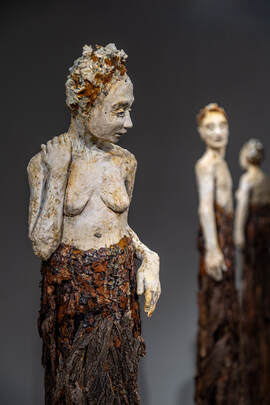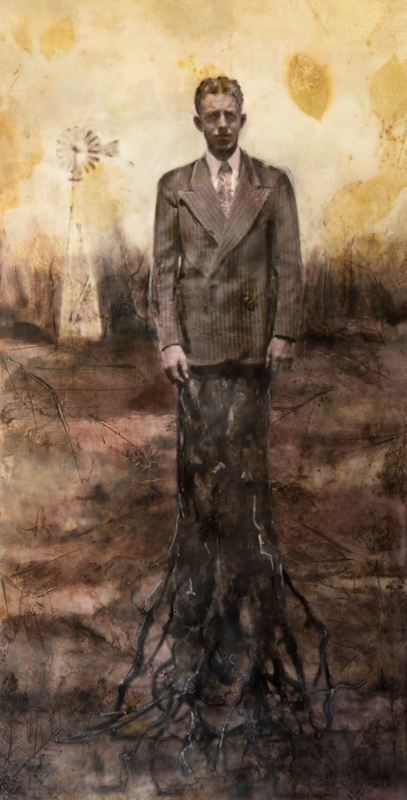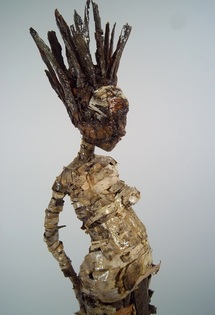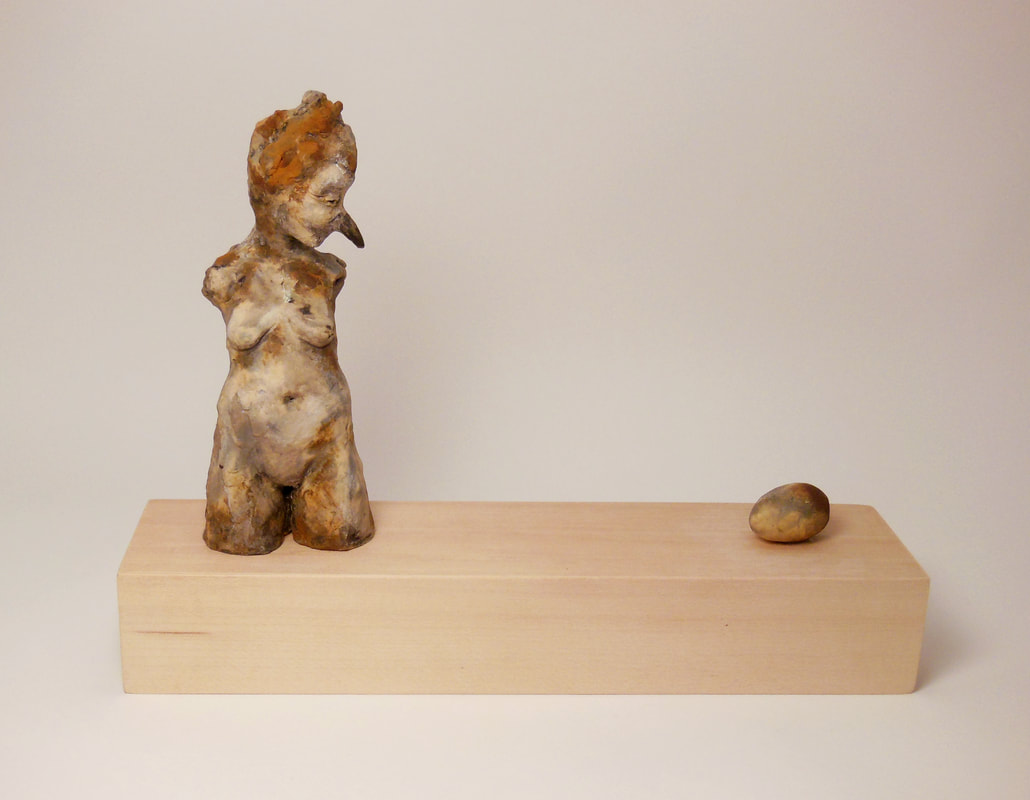|
Putting Down Roots: Installation, Ceramic Mixed Media Sculpture and 2D Encaustic My recent body of mixed media work, collectively titled Putting Down Roots, explores the similar narratives between trees and people, along with my family’s history of putting down their roots in South Dakota in the 1800’s. It consists of smaller, ceramic mixed media sculpture, 2D encaustic pieces and 2 large sculptural installations. The work combines both human and tree form as a representation of these parallels. These beings exist in an in-between space where the boundary lines that separate them are blurred. Some of the common characteristics and themes addressed throughout the work include: putting down our roots and being uprooted, disease, death, new life (saplings/children), dropping our leaves/hair, exfoliating our skin/bark, hosting other living organisms, elimination of population due to natural disaster or human action. The grouping of the large figures in the installation pieces, are meant to be arranged similarly to a forest or shelterbelt. They represent the parallels of people and trees being arranged in communities, and explore the dynamics within those communities. The tall bases are constructed by building an armature and multiple techniques are used to apply pieces of tree bark to resemble a trunk. The tree bark base is cured to kill any dormant insect larvae. The upper portion is made with ceramic. The bodies are sculpted with clay and put through a series of firings in a kiln. After this step, they are joined with the bases and finished with multiple “cold finishing” techniques, meaning they are not fired again. After receiving a collection of family photographs and learning the process of dyeing cloth and paper using the natural pigments found in plants, I began to develop the process for the mixed media encaustic wall pieces. This led me to examine more closely my family’s history of immigrating to Russia from Germany, being uprooted again, and then establishing new roots as immigrants to the United States in north Central SD during the Homestead Act. These pieces begin by collecting plant materials from the South Dakota locations where my family members settled upon immigration, where I grew up in eastern South Dakota and where I have put down my roots as an adult. Paper is dyed with this foliage using a process called eco-dyeing and serves as the background, or first layer. Paper is mounted to panel where a variety of media are applied, including encaustic wax, charcoal, pastel, pan pastel, oil pastel, archival prints of altered images and ink. Old photographs of my ancestors have been combined with my own photographs and images of my sculptures. There is metaphor, representing layers of history, building on a base that is created with the literal environment where we built, and continue to build our lives. The imagery also reflects my family’s experience farming and raising cattle, along with their practice of Catholicism. They, and many other descendants of the “Germans from Russia” during this time, produced very large families, often with 10-15 children per family, partly a result of their religious practices, and can be compared to trees sending off multiple off-shoots through roots and seeds. The work acknowledges the death and tragedy that took place as immigrants settled here, as well as the displacement that results in people continuing to settle here today. My interest in the idea of being in a liminal space or a place of transition, as when being uprooted, comes through in this work. I hope that viewers will be able to feel a connection with others who share a similar background of descent from immigrants and also with people whose story is different, which might include understanding the struggles people may still face from our histories. It is my hope that this art will spark inner reflection and conversations that ultimately lead to us finding the ways in which we are all similar, rather than what separates us. |
|
|
liminality and root-bound body, sky-bound heart (Bird Women series)
This body of work is about metamorphosis, change and personal growth and how that is often an uncomfortable or disorienting process that brings feelings of uncertainty. During these times, one might experience a feeling of longing to be something or someone different. In a similar way to the joining of tree and human, these beings are a combination of person and bird. Is this a bird who is trying to become human, or a human trying to become a bird? What is in the egg? How will that creature have evolved from the creature who laid the egg? Is the egg hers? The ceramic pieces are made from stoneware and b clay, layers of underglazes, copper carbonate, iron paint, ink, encaustic wax, and paint. This work reflects my interest in the in-between spaces of life; the process of changing into new versions of ourselves. Liminality [lim-uh-nal-i-tee] (n): the condition of being on a threshold or at the beginning of a process. Quality of ambiguity that occurs in the middle stage of rituals. During a liminal stage, participants "stand at the threshold" between their previous way of structuring their identity, time, or community, and a new way, which the ritual establishes. |



